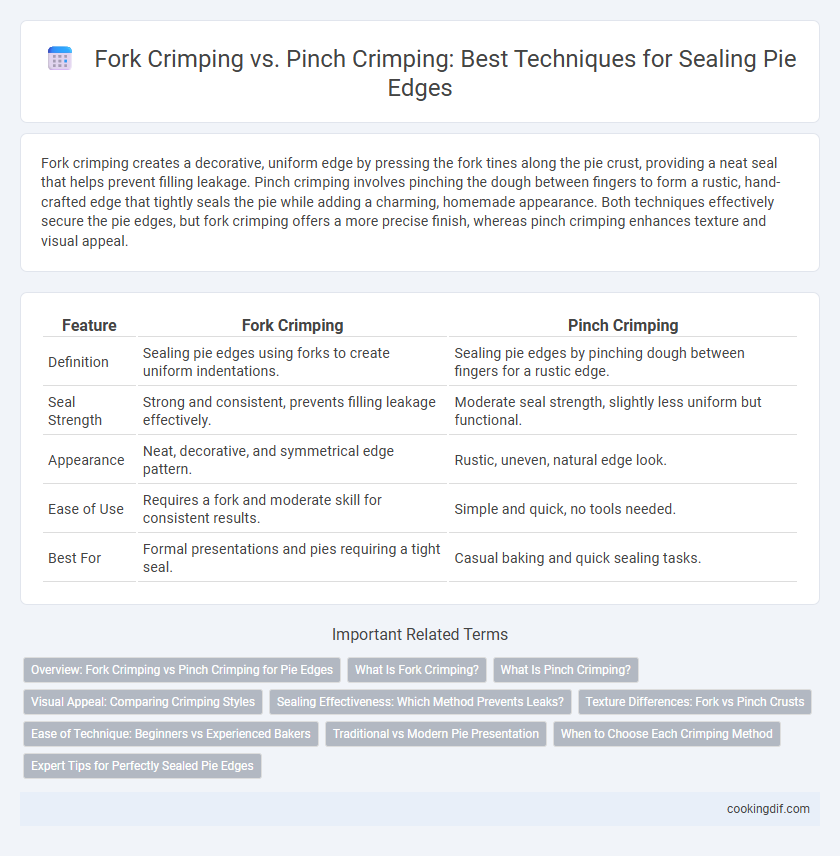Fork crimping creates a decorative, uniform edge by pressing the fork tines along the pie crust, providing a neat seal that helps prevent filling leakage. Pinch crimping involves pinching the dough between fingers to form a rustic, hand-crafted edge that tightly seals the pie while adding a charming, homemade appearance. Both techniques effectively secure the pie edges, but fork crimping offers a more precise finish, whereas pinch crimping enhances texture and visual appeal.
Table of Comparison
| Feature | Fork Crimping | Pinch Crimping |
|---|---|---|
| Definition | Sealing pie edges using forks to create uniform indentations. | Sealing pie edges by pinching dough between fingers for a rustic edge. |
| Seal Strength | Strong and consistent, prevents filling leakage effectively. | Moderate seal strength, slightly less uniform but functional. |
| Appearance | Neat, decorative, and symmetrical edge pattern. | Rustic, uneven, natural edge look. |
| Ease of Use | Requires a fork and moderate skill for consistent results. | Simple and quick, no tools needed. |
| Best For | Formal presentations and pies requiring a tight seal. | Casual baking and quick sealing tasks. |
Overview: Fork Crimping vs Pinch Crimping for Pie Edges
Fork crimping creates a uniform, decorative edge by pressing the tines of a fork into the pie crust, ensuring consistent sealing and a visually appealing finish. Pinch crimping involves pinching the dough between fingers or with the thumb and forefinger to form a raised, textured edge that effectively seals the pie but offers a more rustic appearance. Both techniques enhance crust integrity during baking, but fork crimping provides a smoother seal while pinch crimping yields a sturdier, traditional edge.
What Is Fork Crimping?
Fork crimping is a technique for sealing pie edges by pressing the tines of a fork along the dough rim to create an even, decorative pattern that also helps to firmly join the top and bottom crusts. This method enhances both the pie's aesthetic appeal and structural integrity by preventing filling leakage during baking. Using a fork for crimping provides a consistent seal compared to other methods like pinch crimping, ensuring a well-baked pie with attractive edges.
What Is Pinch Crimping?
Pinch crimping involves pressing the dough edges together between your fingers to create a simple, rustic seal for pie crusts. This technique produces a rough, textured edge that helps prevent the filling from leaking during baking. It is often favored for casual pies where a homemade look is desired and the crust's durability is essential.
Visual Appeal: Comparing Crimping Styles
Fork crimping creates uniform, parallel indentations along the pie edge, offering a consistent and classic visual appeal. Pinch crimping produces a more textured, rustic look with overlapping folds that add depth and homemade charm. The choice between these styles influences the pie's presentation, balancing neatness with artisanal warmth.
Sealing Effectiveness: Which Method Prevents Leaks?
Fork crimping creates consistent, evenly spaced indentations that press the pie crust edges together tightly, reducing the risk of juice leaks during baking. Pinch crimping forms a raised, overlapping edge that provides a stronger mechanical seal but may leave small gaps if not done carefully. For optimal sealing effectiveness in preventing leaks, fork crimping generally offers a more reliable barrier by uniformly compressing the dough edges.
Texture Differences: Fork vs Pinch Crusts
Fork crimping creates evenly spaced, shallow indentations along the pie edge, resulting in a uniform and crisp crust texture that enhances flakiness. Pinch crimping produces deeper, irregular folds, yielding a denser and more rustic crust with a chewy bite. Texture differences influence the overall mouthfeel, where fork-crimped edges tend to be lighter and pinch-crimped edges offer a heartier consistency.
Ease of Technique: Beginners vs Experienced Bakers
Fork crimping offers beginners a simple, reliable method to seal pie edges with consistent results using a common kitchen utensil, requiring minimal skill or practice. Pinch crimping demands more precision and practice, favored by experienced bakers for creating tight, decorative seals that prevent filling leakage. While fork crimping prioritizes ease and speed, pinch crimping excels in control and presentation for advanced pie making.
Traditional vs Modern Pie Presentation
Fork crimping creates a classic, evenly patterned edge that reflects traditional pie-making techniques, while pinch crimping offers a more rustic and textured appearance favored in modern, artisanal pie presentations. Traditional pies often showcase fork crimping for its uniformity and ease, whereas contemporary bakers use pinch crimping to emphasize handcrafted aesthetics and visual appeal. Choosing between fork and pinch crimping significantly influences the pie's overall presentation, texture, and perceived craftsmanship.
When to Choose Each Crimping Method
Fork crimping is ideal for rustic pies or those with thicker dough, providing a strong, decorative seal that prevents filling leakage during baking. Pinch crimping works best with delicate crusts or lattice tops, offering a gentle seal that preserves the pie's visual appeal without compressing the dough excessively. Choose fork crimping for durability and bold aesthetics, while pinch crimping suits tender crusts requiring a subtle finish.
Expert Tips for Perfectly Sealed Pie Edges
Fork crimping creates uniform, decorative ridges by pressing the tines along the pie edge, enhancing both appearance and seal, while pinch crimping involves pinching the dough between fingers for a rustic, tighter closure. Experts recommend fork crimping for delicate, flaky crusts to prevent dough tearing and pinch crimping for heartier, buttery crusts to ensure a secure seal against juices. For perfectly sealed pie edges, chill the dough before crimping and use slight pressure to avoid overworking the crust, ensuring a balance between aesthetics and functionality.
Fork crimping vs Pinch crimping for sealing pie edges Infographic

 cookingdif.com
cookingdif.com